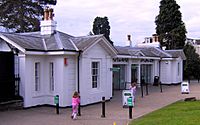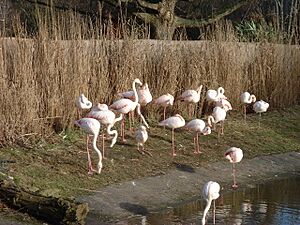Bristol Zoo facts for kids
 |
|

Main entrance
|
|
| Date opened | 1836 |
|---|---|
| Date closed | 3 September 2022 |
| Location | Clifton, Bristol, England |
| Land area | 12 acres (4.9 ha) |
| Coordinates | 51°27′48″N 2°37′20″W / 51.46333°N 2.62222°W |
| No. of animals | 7155 (2007) |
| No. of species | 419 (2007) |
| Annual visitors | 478,126 (2018) |
| Memberships | The Bristol, Clifton and West of England Zoological Society |
| Major exhibits | Zona Brazil, Seal and Penguin Coasts, Gorilla Island |
Bristol Zoo was a famous zoo in the city of Bristol, South West England. Its main goal was to protect nature. It did this by helping endangered species have babies. It also worked to save animal homes and teach people about the natural world.
The zoo had about 300 mammals from 50 different kinds. These included gorillas, Asiatic lions, and red pandas. Some rare animals you could see there were Livingstone's fruit bats and aye ayes.
It had special indoor areas like the Twilight Zone, an insect house, and an aquarium. Outside, there were bird houses and a place for seals and penguins. Islands in the zoo's lakes were home to gorillas, golden lion tamarins, and squirrel monkeys.
On November 27, 2020, the zoo announced it would close its main site in Clifton. This was after more than 186 years. The animals would move to its Wild Place Project site. The zoo officially closed its gates on September 3, 2022. The old zoo land is now being used for new homes.
Contents
Amazing Animal Homes at Bristol Zoo
What Animals Lived at Bristol Zoo?
- Seal and Penguin Coasts was a very popular spot. It opened in 1999. Here, you could watch South American fur seals and African penguins. You could see them both above and below the water. The pools held a lot of salt water. They had waves and waterfalls to make it feel like the animals' natural home. Inca terns and common eiders also lived in this area.
- Gorilla Island was home to a family of western lowland gorillas. The family included a big male gorilla named Jock. Several baby gorillas were born here, like Afia in 2016 and Hasani in 2020. The gorillas had a large island to explore. Keepers did not go into the same space as the gorillas. This was to keep everyone safe and let the gorillas live naturally.
- The Top Terrace was one of the oldest parts of the zoo. It housed a pair of Asiatic lions. You could also see keas, red pandas, Livingstone's fruit bats, and Greater Flamingos here.
- The Reptile House was a warm building filled with reptiles and amphibians. It felt like a rainforest inside. There were sections for desert animals like Gila monsters. Other areas had rainforest creatures like dwarf crocodiles and snakes. You could also see where baby reptiles were raised. Outside, giant tortoises and rhinoceros iguanas had their own space.
- The Aquarium had about 70 different kinds of fish. It had three main sections. One showed fish from the Amazon River, like piranhas. Another showed fish from Africa. The third section was like a coral reef with seahorses and colorful fish. The aquarium also helped protect endangered species of fish.
- Bug World was where the zoo kept its invertebrates. These included Partula snails and stick insects. Other creatures you could see were tarantulas, giant millipedes, and leaf-cutting ants. It was also home to the very rare Desertas Wolf Spider.
- Monkey Jungle opened in 2006. It had new homes for monkeys. You could walk right into the area with crowned lemurs and ring-tailed lemurs. Other enclosures housed brown spider monkeys and lion-tailed macaques. Nearby, black howler monkeys and six-banded armadillos lived. Islands near Gorilla Island were home to squirrel monkeys and golden-headed lion tamarins.
- The Butterfly House was a warm, covered walkway. It was heated in a way that was good for the environment. You could see beautiful butterflies like the blue morpho and atlas moths flying around. The zoo worked with butterfly farms in Costa Rica.
A Look Back: Bristol Zoo's History

Bristol Zoo opened in 1836. It was started by the Bristol, Clifton and West of England Zoological Society. This made it the oldest zoo outside of London. It was a Victorian zoo with walls. It was located near the famous Clifton Suspension Bridge. Even though it was not very big, it had many different species.
In the 1960s, the zoo became famous on TV. It was featured in the UK show Animal Magic. The show's host, Johnny Morris, would pretend to talk to the animals.
The zoo's full name was Bristol Zoological Gardens. This name was used to show it was a place for both animals and beautiful plants. Some of the zoo's original buildings were very old and special. They were even listed as important historical buildings.
Bristol Zoo also had some amazing "firsts" in breeding animals. It was the first place in Britain where a black rhino was born in 1958. It was also the first zoo to have a squirrel monkey born in captivity in 1953. And in 1934, the first chimpanzee in Europe was born here!
Helping Animals: Conservation Work
Bristol Zoological Society (BZS) works hard to protect wildlife. They help with wildlife conservation, education, and breeding programs all over the world. For example, Bristol Zoo worked with other zoos to help lemurs have babies. Lemurs are from Madagascar and are very endangered. This is because their forest homes are being destroyed.
BZS also helps a charity called Ape Action Africa. This group rescues and helps primates in Cameroon, West Africa. Closer to home, the zoo helped bring back animals like the water vole to parts of Southern England. They also had projects for Kordofan giraffes and Sanje Mangabeys.
In 2021, the zoo helped with a special breeding program. They worked to save two kinds of very rare snails from Madeira. These snails were thought to be gone forever. But small groups were found again in 2013.
The Future: Wild Place Project

The Wild Place Project is a newer site. It is designed to be home to larger animals than the old Bristol Zoo. The zoo is divided into different areas called biomes. Each biome shows animals from a specific type of habitat. Some areas include Bear Wood and Discover Madagascar. You can see animals like red river hogs, cheetahs, zebras, gelada baboons, and brown bears here.
The new conservation breeding center will help many rare animals. These include different kinds of turtles and tortoises. It will also help Agalychnis lemurs, Polynesian tree snails, and many kinds of birds.
The Wild Place Project officially opened on July 22, 2013.
Why Did Bristol Zoo Close?
In 2020, BZS announced that Bristol Zoo Gardens would close. The Wild Place Project will become the new Bristol Zoo in early 2024. It will have exciting new animal areas:
- Western lowland gorillas, collared mangabeys, and African grey parrots will live in a new central African rainforest area.
- Eastern black rhinoceros and Ostrich will join the giraffes, zebras, and cheetahs in the Benoue National Park area.
Events at the Zoo
The WOMAD music festival held events at the zoo in 2011 and 2012.
Images for kids
-
South American fur seal seen through the observation windows at Seal and Penguin Coasts, Bristol Zoo.
See also
 In Spanish: Zoo de Bristol para niños
In Spanish: Zoo de Bristol para niños





